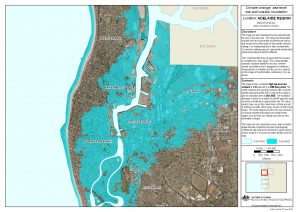
Global warming and sea level rise sometimes seems like a lot of hype bandied about by the media and politicians. However, it has a different level of importance for scientists in a range of disciplines around the world. The Australian Curriculum emphasises that students should study sustainability and environment issues in HASS and Science subjects, from lower primary school up. This is not just because its fashionable at the moment, but rather because even casual reading of the science tells us that these are going to be some of the most critical issues faced by our children in years to come. The world has already lost inhabited islands to sea level rise, with communities being moved out of their flooded homes. Eight of these islands are in the Pacific. In the Solomon Islands one inhabited island has already lost 75% of its houses to the sea, since 2011.
 Global warming and sea level rise are related because a warmer global environment melts the ice at the poles and causes the sea level to rise. The same thing happened at the end of the last Ice Age, 12,000 years ago. In a paper just published in the respectable journal, Nature, Australian scientists (with some international colleagues) present two alternatives for the future of Antarctica (and thus for the future sea level rises around the world). The two lead authors (from the CSIRO and Monash University) have also published a slightly simpler version of this paper, highlighting the key points. The two scenarios explored are based on the kind of action that we all take now to reduce global warming, greenhouse gas emissions and human impacts on the fragile polar environments. The authors argue that actions need to take place within the next decade.
Global warming and sea level rise are related because a warmer global environment melts the ice at the poles and causes the sea level to rise. The same thing happened at the end of the last Ice Age, 12,000 years ago. In a paper just published in the respectable journal, Nature, Australian scientists (with some international colleagues) present two alternatives for the future of Antarctica (and thus for the future sea level rises around the world). The two lead authors (from the CSIRO and Monash University) have also published a slightly simpler version of this paper, highlighting the key points. The two scenarios explored are based on the kind of action that we all take now to reduce global warming, greenhouse gas emissions and human impacts on the fragile polar environments. The authors argue that actions need to take place within the next decade.
 Scenario 1 has us take sudden, urgent action to reduce global warming and greenhouse gas emissions worldwide, as well as putting policies in place to control and reduce human impacts on the poles, and Antarctica in particular (reducing numbers of people in Antarctica, as well as their impact there). The situation 50 years from now (a time scale chosen to reflect the lifetimes of today’s children) has Antarctica enjoying a similar environment to today. The ozone hole has been repaired and the climate remains similar to that of the 20th century. The rate at which the ice has thinned has remained constant, instead of accelerating, and the acidification of the sea water has been kept low. The sea ice has decreased by “only” 12% and the ice on land by “only” 8%. Marine animals and birds show only small declines in population. Antarctica has been protected from invasive plants and animals through decreased human access and impact and maintenance of the harsh climate. Global air temperature has risen by less than 1 degree Celsius. Overall the sea level will rise by just under 1 metre, of which only 6cm comes from melting ice in West Antarctica.
Scenario 1 has us take sudden, urgent action to reduce global warming and greenhouse gas emissions worldwide, as well as putting policies in place to control and reduce human impacts on the poles, and Antarctica in particular (reducing numbers of people in Antarctica, as well as their impact there). The situation 50 years from now (a time scale chosen to reflect the lifetimes of today’s children) has Antarctica enjoying a similar environment to today. The ozone hole has been repaired and the climate remains similar to that of the 20th century. The rate at which the ice has thinned has remained constant, instead of accelerating, and the acidification of the sea water has been kept low. The sea ice has decreased by “only” 12% and the ice on land by “only” 8%. Marine animals and birds show only small declines in population. Antarctica has been protected from invasive plants and animals through decreased human access and impact and maintenance of the harsh climate. Global air temperature has risen by less than 1 degree Celsius. Overall the sea level will rise by just under 1 metre, of which only 6cm comes from melting ice in West Antarctica.

Scenario 2 has us take very little to no action to reduce global warming, greenhouse gases and human impacts on Antarctica. Fossil fuel use and deforestation have continued and there has been no regulation of human access to Antarctica. Global air temperatures have risen by more than 3.5 degrees Celsius. The oceans have warmed and become more acidic – at levels that corrode marine shells and the exoskeletons of marine animals. Ice shelves in Antarctica have collapsed, accelerating the melting of ice and icebergs pose a continual risk to fishing, tourist and commercial shipping fleets. Sea ice is reduced by almost half. In this scenario, global sea levels rise at rates similar to that at the end of the Ice Age, gaining 3 metres by the year 2300 and more than half a metre in the first 50 years alone. Fisheries around the world are collapsing, and animals (such as penguins, seals and whales) who depend upon fish are in sharp decline. Antarctica has been colonised by invasive species of plants and animals, further disrupting the ecosystem and preventing ice from reforming in some areas. Antarctica is also being denuded of its original nature by rampant harvesting of resources, including mining, and the arrival of about 1 million tourists per year, who come to try to catch a glimpse of what Antarctica used to be, before it all disappears.

This sounds like a doom and gloom scenario, but it is one of the most likely scenarios, with the impact on our way of life being severe. Websites are now available to examine what sea level rises mean for our coastal cites. The impact varies in different cities, with Adelaide and Cairns being amongst the worst affected, although Brisbane’s port and airport are also in trouble. None of our coastal cities are exempt. These pictures show a 1.1m sea level rise by the year 2100 – close to the best case scenario mentioned above! They also do not take into account storm surges, erosion and other effects as our weather systems continue to be disrupted by the changing world environment. Now imagine 3 times that amount of impact, as forecast by the worst case scenario!
This is our children’s future. We need to prepare them well for handling these disasters. They need to understand how these have happened and what can be done to mitigate the effects of these changes. It is the job of all parents and educators to guide our children to develop the skills to interpret, understand and act in creative and innovative ways when tackling problem-solving and to start discussing these issues of their future now. Science, and the Scientific Method in particular, is an essential tool and the only hope that we have of both tracking what is happening and monitoring the efficacy of possible solutions.


My grade 4 son played this with me a few times, his feedback was it was too easy but fun,…
Brad